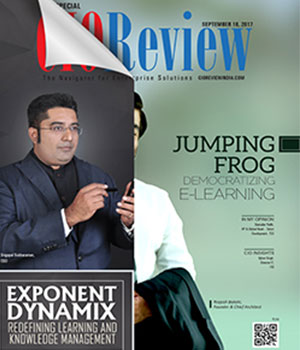
Innovating Intelligently
Joe Iannello, VP & CIO, Capital Metro | Monday, 24 October 2016, 06:18 IST
 Regardless of what business you are in, whether you work in the private or public sector—if you are selling or providing a product or service to your customers—then innovation is a critical success factor in gaining and retaining market share. This has become a reality today and will be ever more important as we move into the future. This article focuses on innovation based upon mobile ticketing app technology and the benefits and impact on customers.
Regardless of what business you are in, whether you work in the private or public sector—if you are selling or providing a product or service to your customers—then innovation is a critical success factor in gaining and retaining market share. This has become a reality today and will be ever more important as we move into the future. This article focuses on innovation based upon mobile ticketing app technology and the benefits and impact on customers.
Less than a decade ago, in 2007, Apple first introduced the iPhone. Google soon followed with Android phones and later Microsoft with Windows phones. A revolution began with smartphone and tablet mobile apps becoming available for just about everything. An amazing number of more than three million different mobile apps exist today across all of those platforms. While there are many apps to choose from and many are variations on the same theme—a unique element that you control is related to whatever product or service you sell. Take for example, a public transit agency that provides mass transit bus and/or rail services. There may be other transportation providers and many mobile apps supporting travel—but, only the transit agency provides its transit services and only it can establish or change service routes and sell tickets.
Mobile ticketing apps for transit existed in Europe a number of years before becoming available in the USA. Capital Metro, the public transit agency that provides services in Austin, Texas, was one of the first transit agencies in the nation in January, 2014 to introduce mobile ticketing, through its’ partnership with mobile ticketing app provider Bytemark, across all services—including Local, Flyer, Express, and MetroRapid bus routes; MetroRail and MetroAccess services. The app, known as CapMetro, is available for free download in the Apple, Android or Windows app stores. Using the app, tickets can be purchased and then the smart phone or tablet can be used as the electronic ticket to board the vehicle. Additional features include various traveler tools including trip planning, schedules, maps and next departure times based upon real-time data.
The CapMetro app has been very successful and it has generated, to date, millions of dollars of ticket sales and hundreds of thousands of downloads and usage continues to increase significantly. Additionally, this solution has received many innovation awards each year since its’ initial launch.
In addition to the customer/traveler benefits and the recognition received—a key point is that— innovation breeds innovation. Technology companies and others will be more inclined to partner with an organization that is not only willing and able to try something new but, also, if there has been some prior success with innovation projects. Additionally, innovation spawns other opportunities. For example, Capital Metro success with mobile ticketing and other innovations such as smart infrastructure supporting vehicle movements and real-time open data have been factors in Austin being selected, in 2015, as the lead city in nation for the Mobility Transformation Initiative that is being facilitated by the Rocky Mountain Institute. Another example was Austin being selected, this year, as a finalist in the Smart City Challenge by the US Department of Transportation.
Innovation is like so many things—easier said than done—especially when you consider not only competing priorities but, also, the resistance that might be encountered or the cultural change required. That is why there is increasing discussion of “Bi-Modal Approach” to projects— one mode that has been in existence for decades addressing traditional projects and systems— and now a second newer mode focused on innovation projects which require not only an agile project development methodology but, really needs to address the mindset and process changes needed throughout the organization to address the full life cycle of exploration, budgeting, acquisition/procurement, project management, development, testing, marketing, piloting, launching, refreshes and leveraging investments.
CIO’s today are undoubtedly faced with many challenges including Internal Systems Modernization and Support, On-premises and Cloud Infrastructure, Cyber Security, Data Management, Staffing, Vendor and Project Management, just to name a few. The good news is that there are opportunities everywhere including emerging technologies such as Advanced Mobile Technology, Internet-of-Things, Autonomous Devices and Vehicles, 3D Printing and Gigabit Wireless Communications. Developing a balanced portfolio that includes customer focused innovation is a critical success factor which will result in not only serving your customers but, also, will yield additional opportunities as we move into the future.
CIO Viewpoint
IT DOES MATTER - The causes and costs of data...
By Upkar Singh, Director IT, FIS
Why Artificial Intelligence will Empower the CIO
By Gregory B. Morrison, SVP & CIO, Cox Enterprises
LMS - Present and Future Trends
By Milind Gokhale, VP–Technology and Learning Platforms, Tata Interactive Systems
CXO Insights
How Digital Learning helps Businesses Increase...
By By Saratchandra Panganamamula, Head of SAP HCM/SF Practice, YASH Technologies
What Could 5G Mean to the World of Enterprise?
By Danessa Lambdin, VP, Mobility Product Management, AT&T Business Marketing
Strategy & Execution for Healthcare Analytics...


.jpg)





